 Petzlover
Petzlover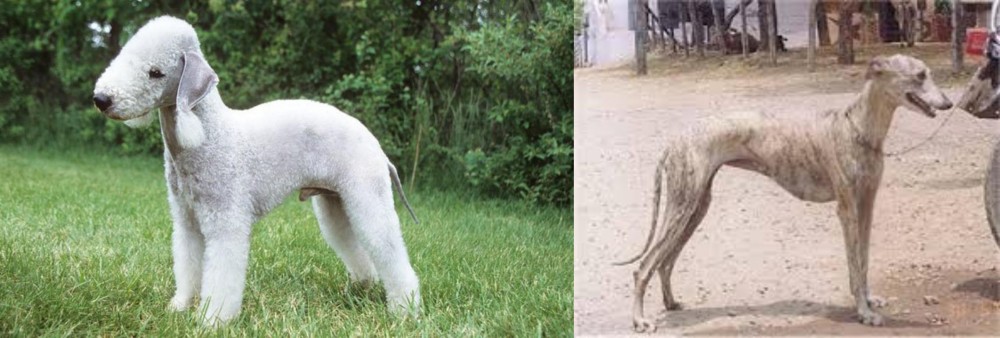 Bedlington Terrier is originated from United Kingdom but Rampur Greyhound is originated from India. Bedlington Terrier may grow 31 cm / 12 inches shorter than Rampur Greyhound. Bedlington Terrier may weigh 19 kg / 41 pounds lesser than Rampur Greyhound. Both Bedlington Terrier and Rampur Greyhound has same life span. Bedlington Terrier may have less litter size than Rampur Greyhound. Both Bedlington Terrier and Rampur Greyhound requires Low Maintenance.
Bedlington Terrier is originated from United Kingdom but Rampur Greyhound is originated from India. Bedlington Terrier may grow 31 cm / 12 inches shorter than Rampur Greyhound. Bedlington Terrier may weigh 19 kg / 41 pounds lesser than Rampur Greyhound. Both Bedlington Terrier and Rampur Greyhound has same life span. Bedlington Terrier may have less litter size than Rampur Greyhound. Both Bedlington Terrier and Rampur Greyhound requires Low Maintenance.
 Originally known as Rodbury Terriers or Rothbury’s Lambs, and renowned for looking like a lamb, the Bedlington Terrier was bred in the village of Bedlington in Northumberland. They’ve had other names too and were also known as ‘gypsy dogs’ and this is because gypsies used them to hunt.
Originally known as Rodbury Terriers or Rothbury’s Lambs, and renowned for looking like a lamb, the Bedlington Terrier was bred in the village of Bedlington in Northumberland. They’ve had other names too and were also known as ‘gypsy dogs’ and this is because gypsies used them to hunt.
The Bedlington Terrier Club was established in 1875 and the National Bedlington Terrier Club was formed in England in 1877. The breed has links with the Dandie Dinmont Terrier, the Kerry Blue Terrier and the Soft Coated Wheaten Terrier. When you look at the slightly arched back, it could also be related to the Whippet. They have been crossed with Whippets to get that speed, and feisty character.
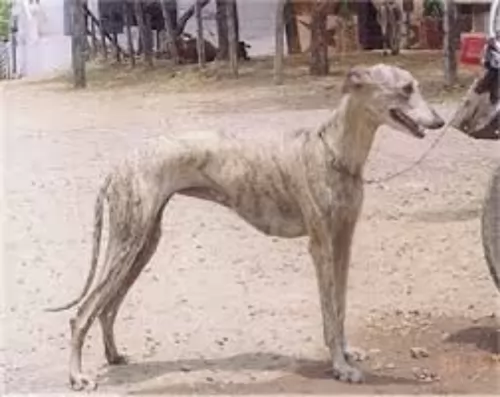 Known also as the North-Indian Greyhound or the Rampur Hound, the Rampur Greyhound is native to the Rampur area of Northern India.
Known also as the North-Indian Greyhound or the Rampur Hound, the Rampur Greyhound is native to the Rampur area of Northern India.
This dog is a member of the sighthound family, and in the past has been sought after for its efforts in controlling jackals.
The dog is also able to cover large distances at high speed. Some commemorative postage stamps were issued in 2005 as acknowledgement of this attractive dog breed.
 Don’t let their lamb-like appearance fool you – the Bedlington Terrier is a plucky dog who has some amazing speeds when it comes to swimming and running. This is an intelligent dog too and every bit a Terrier in spirit. Their tenacity has seen them being used in dog fighting as well.
Don’t let their lamb-like appearance fool you – the Bedlington Terrier is a plucky dog who has some amazing speeds when it comes to swimming and running. This is an intelligent dog too and every bit a Terrier in spirit. Their tenacity has seen them being used in dog fighting as well.
The Bedlington Terrier stands at about 41cm in height and weighs between 8 – 10kg. Muscular, with a deep chest, graceful and lithe, not only does he look like a lamb but the dog’s expression is gentle too with bright deep-set eyes. When it comes to his coat, the dogs have blue, sandy or liver color coats and the coat has tan markings in some areas.
The coat is shaggy and is made up of hard- and soft hair that will need to be regularly trimmed. Known as a hypoallergenic breed, the coat is also described as thick and linty. The ears are floppy with rounded tips, and are thin and velvety in texture with a small silky tassel at the tip. The longish tail is set low and tapers down to a point.
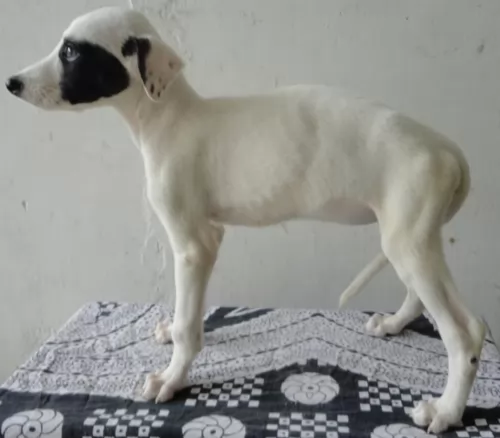 In height, the Rampur Greyhound stands at between 55 and 75 cm and they weigh in the region of 27 to 30kg.
In height, the Rampur Greyhound stands at between 55 and 75 cm and they weigh in the region of 27 to 30kg.
They are much the same as other greyhounds, but they’re somewhat wider and just a little bit more muscular. The head too, is broader than the slimmer head of the English Greyhound. Of course these dogs are known for the slim, pointed nose, the high-set ears which are sometimes half-floppy, half-erect. The eyes are large and the tail is long and slim.
The coat is short and smooth and is in colors such as gray, fawn, some white, some black with white and some brindle.
Your Rampur Greyhound is social around his human family, lapping up all their attention. He is the kind of dog that can be seen sprinting at high speed over the fields, but he is also not averse to lying peacefully with you on the sofa.
He is far better suited to a home with large gardens or on a farm as opposed to being confined to a small property in the city.
He can be gentle but when required, he becomes an excellent watchdog. He will need training and socialization as he can be rambunctious indoors, knocking things over. Training makes him obedient and restrained They get on well with children and other pets in the home.
 You can’t miss the Bedlington Terrier – he has a striking resemblance to a lamb. The curly coat is interesting too – a mix of hard- and soft hair. He is friendly, loyal and devoted to his human family and is known to be a brave, courageous, feisty dog with the inclination to bark more. Socialization and training can change this though. He gets on well with children and other pets in the home. He isn’t aggressive but if taunted, he can put up a good fight.
You can’t miss the Bedlington Terrier – he has a striking resemblance to a lamb. The curly coat is interesting too – a mix of hard- and soft hair. He is friendly, loyal and devoted to his human family and is known to be a brave, courageous, feisty dog with the inclination to bark more. Socialization and training can change this though. He gets on well with children and other pets in the home. He isn’t aggressive but if taunted, he can put up a good fight.
This is a dog that can adapt to his surroundings so he slots in well to both city- and country living. Wherever he lives, he will need adequate exercise.
The present-day Bedlington Terrier, inducted by the American Kennel Club in 1967, is not a lamb by any means, and by choosing to have him as your pet, you’ll be amazed at his wonderful qualities that make him such in ideal companion.
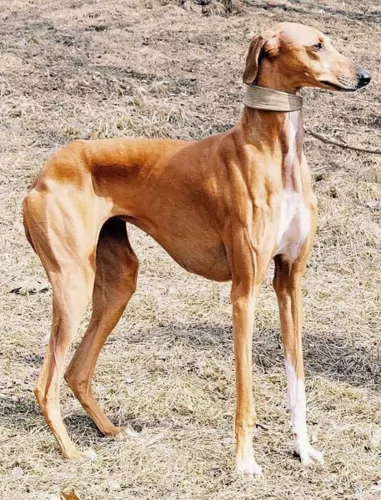 Everyone loves the Rampur Greyhound, and why not? He is fantastic with children because of his gentle, loving nature. He is a playful dog too and will require a daily dose of exercise.
Everyone loves the Rampur Greyhound, and why not? He is fantastic with children because of his gentle, loving nature. He is a playful dog too and will require a daily dose of exercise.
They aren’t noisy dogs, being naturally timid, but he still loves to get out and about with his daily walk to see and experience new sights and smells.
When you bring a Rampur Greyhound into your home, you’re bringing in a whole lot of wonderful companionship, love and loyalty from this remarkable canine.
 Bedlington Terriers are a healthy breed, but just like other dogs, they are prone to some common dog illnesses. You can always ensure that your Bedlington reaches his 12 – 14 years of age lifespan by ensuring his vaccines are kept up to date, that he is fed excellent food and fresh water, he is exercised and that he is loved and cherished. Also, if you’re looking to buy a Bedlington, find a reputable breeder.
Bedlington Terriers are a healthy breed, but just like other dogs, they are prone to some common dog illnesses. You can always ensure that your Bedlington reaches his 12 – 14 years of age lifespan by ensuring his vaccines are kept up to date, that he is fed excellent food and fresh water, he is exercised and that he is loved and cherished. Also, if you’re looking to buy a Bedlington, find a reputable breeder.
Some common health issues to look out for in your Bedlington Terrier include -
Hip dysplasia
Different eye diseases
Hypothyroidism
Copper storage hepatopathy or Liver Disease – this is a disease which can be inherited and where large amounts of copper accumulate in the tissues of the liver. The result is inflammation and cell damage and this can lead to liver failure and even death. Abdominal swelling, jaundice and weight loss are symptoms to watch for with this disease.
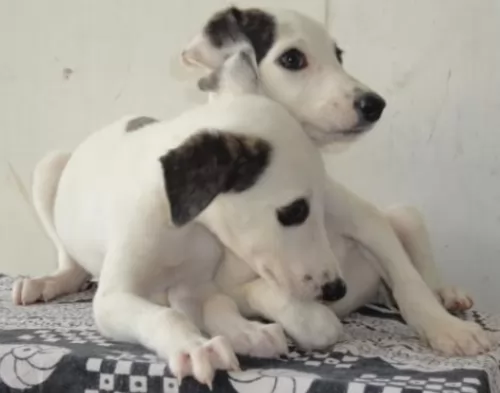 Rampur Hounds are generally a healthy dog breed, and their health is enhanced when you take good care of them and provide them with lots of love, good food and exercise.
Rampur Hounds are generally a healthy dog breed, and their health is enhanced when you take good care of them and provide them with lots of love, good food and exercise.
Still, every dog can fall prey to any one of the many dog illnesses there are such as cancer, bloat, diabetes, ear infections, epilepsy, obesity, eye problems and others.
This can be deadly for your dog. Gas collects in the stomach and the stomach can twist. You’ll notice your dog has a hard, swollen stomach and he is lethargic, but restless. Getting him to the vet as quickly as possible should be a top priority.
Your pet can develop all kinds of skin problems where he bites and scratches, causing bacteria. It can be terribly painful for your pet, and even ticks and fleas on the skin can cause cause a lot of irritation for your pet.
Some people add in omega 3 oils to their pet’s diet to help with dry skin. Don’t let your pet suffer with skin allergies and other problems that are itchy and painful. Get him to the vet so you can get to the root of what is causing him so much frustration with his skin.
 The Bedlington Terrier is a lively, cheerful companion at home and is somewhat more relaxed than other terrier breeds. Affectionate and loyal, he just loves to spend time with his human family. He’ll love to be your companion on a walk and he gets delighted when you’re ready to play ball games with him. He makes a great friend for children too, and even though he makes a good watchdog, he will welcome any visitors you have. When trained and socialized he becomes an obedient, well behaved member of the family.
The Bedlington Terrier is a lively, cheerful companion at home and is somewhat more relaxed than other terrier breeds. Affectionate and loyal, he just loves to spend time with his human family. He’ll love to be your companion on a walk and he gets delighted when you’re ready to play ball games with him. He makes a great friend for children too, and even though he makes a good watchdog, he will welcome any visitors you have. When trained and socialized he becomes an obedient, well behaved member of the family.
The Bedlington coat sheds a little but the rough coat will need to be trimmed regularly and the coat brushed twice a week to ensure no tangling and to remove loose hairs. Also, regular cleaning of teeth and ears can help ensure that harmful bacteria doesn’t build up, ensuring the overall health of your dog.
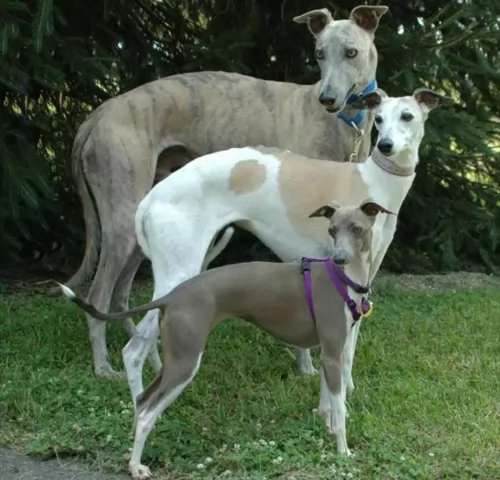 Active and playful, your Rampur Hound will need a lot of space to let off steam and run. He will look forward to his walks every day with you. Maybe you’ll need a tennis racquet to hit the ball far enough for him to sprint after.
Active and playful, your Rampur Hound will need a lot of space to let off steam and run. He will look forward to his walks every day with you. Maybe you’ll need a tennis racquet to hit the ball far enough for him to sprint after.
These dogs, with their short coats, are considered to be low maintenance, even though they do shed.
A good brush twice a week will do them good and they just love being massaged. It’s your time to run your hands over the slim, muscled body to make sure there are no unusual lumps on him.
Follow a regular grooming regime when you brush him. Check inside his ears, have a look at his eyes to make sure they’re still bright. Check inside his mouth for bad teeth which could be causing him terrible pain and make sure to trim his nails.
To be healthy and content, every dog needs good food.For convenience it can be great to feed your Greyhound one of the high quality commercially manufactured dog foods. To vary the food occasionally, add in some delicious home-made food too.
Once or twice a week you can simply add some home-made food to the dry kibble. Boiled chicken, brown rice or pasta and spinach, sweet potatoes and carrots are a healthy choice for your pet. Nothing complicated.
If you cook it in bulk, you can chop it all up and feed smaller portions to your pet. Some raw meat added in from time to time will also keep him healthy.
A simple meal like this will please your dog no end. No exotic spices and strange, weird kinds of food which could upset his stomach – just plain and simple the way dogs love it.
Ensure there is always a bowl of fresh, cool water within his reach.